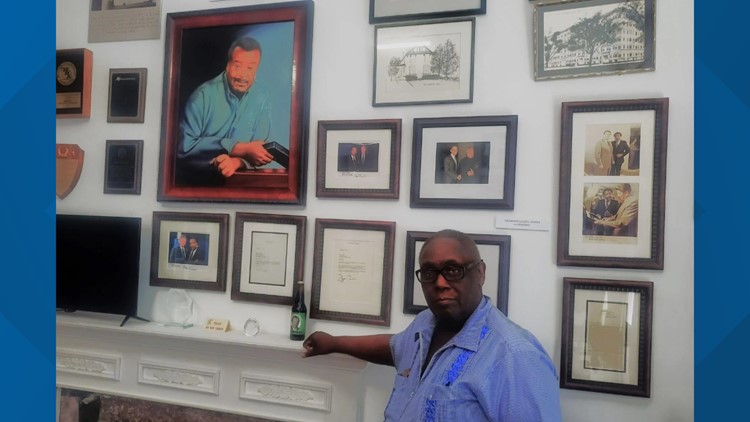The “Julius Hunter Media Room” was dedicated on Saturday, June 3, 2023. The exhibit features a cardboard cutout of Hunter, wall-to-wall, floor-to-ceiling artifacts, awards, framed photos, videos and other memorabilia highlighting Hunter’s remarkable broadcast, print and public service career that spanned four decades.
“We are so pleased and proud to honor Julius Hunter. He is St. Louis through and through” said Calvin Riley, founder of the museum. “His groundbreaking work on local television set the path for countless other Black journalists in town and across the country.”
Starting as a reporter at KSDK, Hunter made broadcasting history in 1970, when he became the first African American full-time primetime TV news anchorman in St. Louis. After moving to KMOV (then KMOX), Hunter covered local, regional, national and international news.
He interviewed six incumbent U.S. Presidents and countless local and nationally known politicians. In the late 1970s, Hunter broadcast live reports from Rome on the deaths of Paul VI and John Paul I respectively. He even traveled on three occasions with Pope John Paul II.
The list of Hunter’s exclusive interviews reads like a “who’s who” of politics and entertainment-including luminary sit-downs with Pearl Bailey, Ted Kennedy, Julia Child, Jimmy Hoffa, Angie Dickinson, Oprah Winfrey, Cab Calloway, Sophia Loren, Chuck Berry and many more.
Hunter’s contributions to St. Louis have reached well beyond television. He wrote a weekly column for the St. Louis Post-Dispatch and occasionally writes commentaries for this newspaper. He is the author of a dozen published books. Hunter has also served on the Boards of the History Museum, The BackStoppers, Campbell House Museum, St. Louis Police Department, and most recently the Landmarks Association.
Hunter said he’s been a long-time supporter of Riley and the museum. His contributions include efforts to get press coverage for the gallery. He’s also working to help install an elevator to the two-story mansion which Hunter described as a "Yeoman’s" effort.
“The original elevator was installed in the 1890's and we learned, a short time ago, that it is too ancient to be safe. It must be gutted and totally rebuilt,” the newsman explained.
To secure funds and support Hunter has hosted fundraisers and introduced Riley to prospective donors, philanthropists and a noted architect who, he said, successfully constructed an elevator that runs between floors outside a building.
Hunter said there was no vanity involved when he allowed Riley to dedicate a permanent exhibit in his name.
“I agreed to have the room named after me only because I hope it will draw visitors to look at the massive, mammoth collection on the first floor,” Hunter said, adding: “And that seems to be working.”
This has been the George B. Vashon Museum’s “busiest year,” Riley noted, adding that about 60 Cahokia School District students would be visiting in a couple days.
Riley and his wife, Calra, started the museum about 10 years ago but the curator said he’s been collecting artifacts for more than 40 years.
The mansion, which was once a funeral parlor, still has colorful mosaic stained glass windows on the first floor. It holds thousands of artifacts representing 250 years of local and national African American history.
A space dedicated to civil rights contains KKK memorabilia and an original sign from the Lorraine Motel where Dr. Martin Luther King, Jr. was assassinated in 1968.
There is also a room containing original documents from the Dred Scott case and other spaces dedicated to local high-profile dignitaries such as Senator J.B. Jet Banks, scientist and chemist, Dr. Lincoln Diuguid, commercial artist,Spencer Thornton Banks and, of course, pioneering attorney, scholar, lawyer and abolitionist, George Boyer Vashon.
The museum is located at 2223 St Louis Ave, in the heart of what was once the thriving St. Louis Place neighborhood. In 2014, St. Louis Magazine described the area as one of “stunning Italianate, Second Empire and Romanesque Revival mansions…” that “easily challenged the more famous South Side neighborhood for sheer beauty and preservation of its stately mansions.”
Even though the museum receives hundreds of tours, out-of-town guests and local visitors, it is still an unknown gem to many St. Louisans.
Hopefully, the installation of the new “Julius Hunter Media Room” will draw more visitors interested in the rich and diverse history of St. Louis and its many native personalities.


